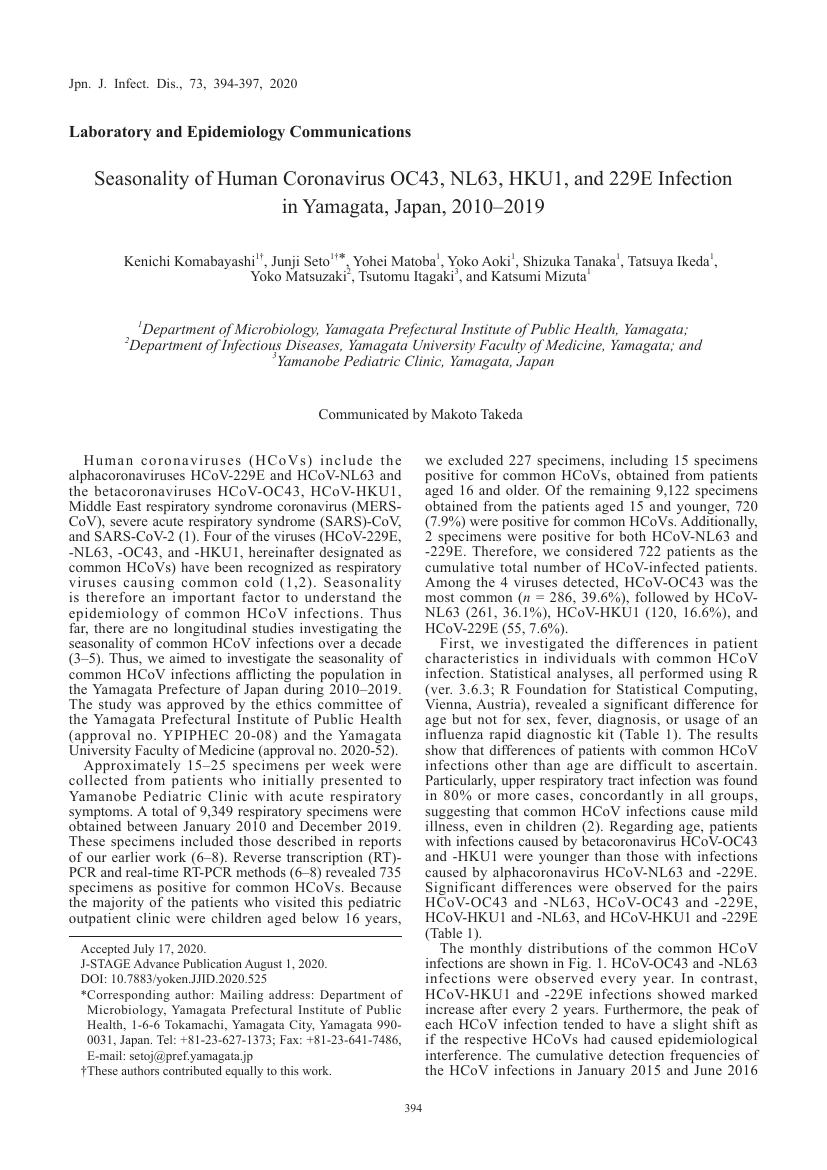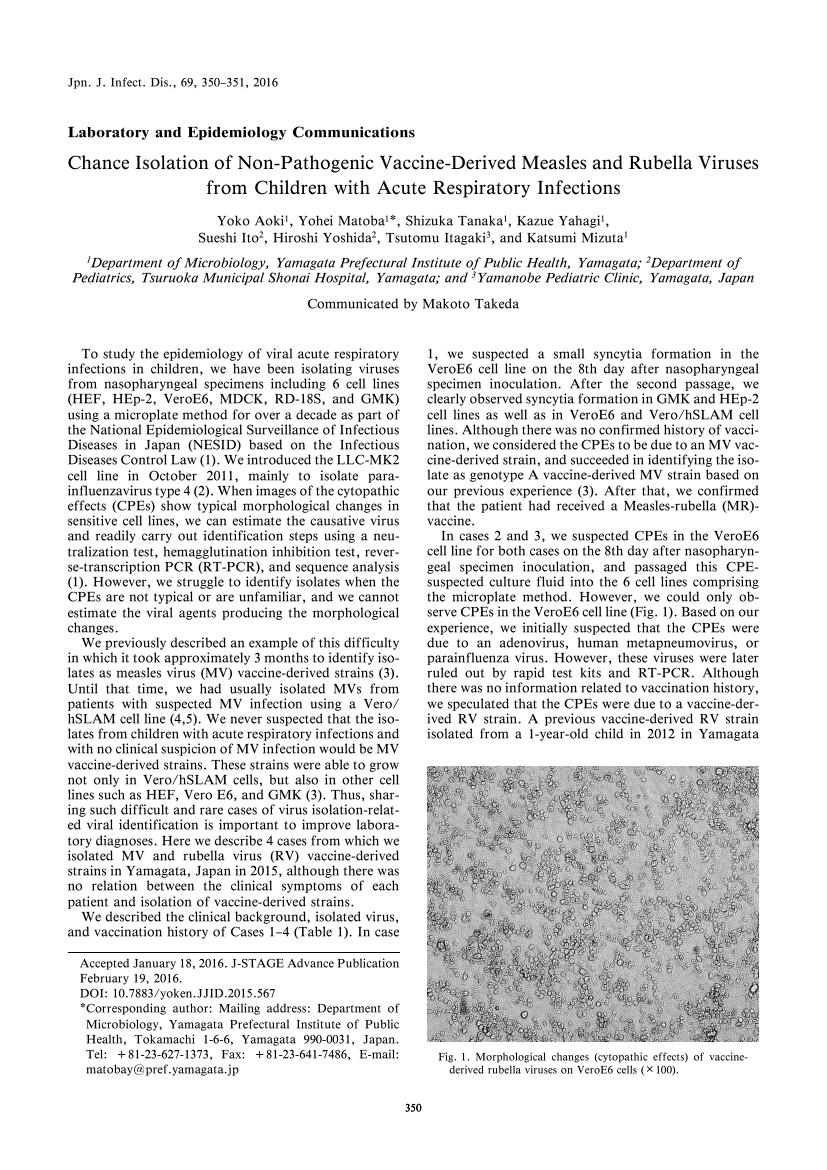49 0 0 0 OA Seasonality of human coronavirus OC43, NL63, HKU1, and 229E infection in Yamagata, Japan, 2010–2019
- 著者
- Kenichi Komabayashi Junji Seto Yohei Matoba Yoko Aoki Shizuka Tanaka Tatsuya Ikeda Yoko Matsuzaki Tsutomu Itagaki Katsumi Mizuta
- 出版者
- National Institute of Infectious Diseases, Japanese Journal of Infectious Diseases Editorial Committee
- 雑誌
- Japanese Journal of Infectious Diseases (ISSN:13446304)
- 巻号頁・発行日
- pp.JJID.2020.525, (Released:2020-08-01)
- 参考文献数
- 10
- 被引用文献数
- 1 18
- 著者
- Kenichi Komabayashi Yohei Matoba Junji Seto Yoko Ikeda Waka Tanaka Yoko Aoki Tatsuya Ikeda Yoko Matsuzaki Tsutomu Itagaki Kazuya Shirato Katsumi Mizuta
- 出版者
- National Institute of Infectious Diseases, Japanese Journal of Infectious Diseases Editorial Committee
- 雑誌
- Japanese Journal of Infectious Diseases (ISSN:13446304)
- 巻号頁・発行日
- pp.JJID.2020.776, (Released:2020-11-30)
- 参考文献数
- 31
- 被引用文献数
- 7
Isolation of seasonal coronaviruses, which include human coronavirus (HCoV) OC43, HCoV-HKU1, and HCoV-NL63, from primary cultures is difficult because it requires experienced handling, an exception being HCoV-229E, which can be isolated using cell lines such as RD-18S and HeLa-ACE2-TMPRSS2. We aimed to isolate seasonal CoVs in Yamagata, Japan to obtain infective virions useful for further research and to accelerate fundamental studies on HCoVs and SARS-CoV-2. Using modified air-liquid interface (ALI) culture of the normal human airway epithelium from earlier studies, we isolated 29 HCoVs (80.6%: 16, 6, 6, and 1 isolates of HCoV-OC43, HCoV-HKU1, HCoV-NL63, and HCoV-229E, respectively) from 36 cryopreserved nasopharyngeal specimens. In ALI cultures of HCoV-OC43 and HCoV-NL63, the harvested medium contained more than 1×104 genome copies/µL at every tested time point during the more than 100 days of culture. Four isolates of HCoV-NL63 were further subcultured and successfully propagated in an LLC-MK2 cell line. Our results suggest that ALI culture is useful for isolating seasonal CoVs and sustainably obtaining HCoV-OC43 and HCoV-NL63 virions. Furthermore, the LLC-MK2 cell line in combination with ALI cultures can be used for the large-scale culturing of HCoV-NL63. Further investigations are necessary to develop methods for culturing difficult-to-culture seasonal CoVs in cell lines.
9 0 0 0 OA Seasonality of Human Coronavirus OC43, NL63, HKU1, and 229E Infection in Yamagata, Japan, 2010–2019
- 著者
- Kenichi Komabayashi Junji Seto Yohei Matoba Yoko Aoki Shizuka Tanaka Tatsuya Ikeda Yoko Matsuzaki Tsutomu Itagaki Katsumi Mizuta
- 出版者
- National Institute of Infectious Diseases, Japanese Journal of Infectious Diseases Editorial Committee
- 雑誌
- Japanese Journal of Infectious Diseases (ISSN:13446304)
- 巻号頁・発行日
- vol.73, no.5, pp.394-397, 2020-09-30 (Released:2020-09-24)
- 参考文献数
- 10
- 被引用文献数
- 2 18
- 著者
- Yohei Matoba Chieko Abiko Tatsuya Ikeda Yoko Aoki Yu Suzuki Kazue Yahagi Yoko Matsuzaki Tsutomu Itagaki Fumio Katsushima Yuriko Katsushima Katsumi Mizuta
- 出版者
- National Institute of Infectious Diseases, Japanese Journal of Infectious Diseases Editorial Committee
- 雑誌
- Japanese Journal of Infectious Diseases (ISSN:13446304)
- 巻号頁・発行日
- vol.68, no.2, pp.138-141, 2015 (Released:2015-03-23)
- 参考文献数
- 24
- 被引用文献数
- 40 74
The available literature on human coronaviruses (HCoVs) in Japan is limited to epidemiological studies conducted over a maximum of 1 year. We conducted a 4-year study of HCoVs by analyzing 4,342 respiratory specimens obtained in Yamagata, Japan, between January 2010 and December 2013. A pan-coronavirus reverse transcription-PCR screening assay was performed, and all HCoV-positive specimens were subsequently confirmed by sequencing of the PCR products. We detected in 332 (7.6%) HCoV strains during the study period, comprising 133 (3.1%) HCoV-NL63, 83 (1.9%) HCoV-HKU1, 78 (1.8%) HCoV-OC43, and 38 (0.9%) HCoV-229E strains. HCoV detection per year ranged from 3.5% to 9.7%. HCoVs were detected mainly in winter, with January (28.5%) and February (25.3%) 2011 and December 2012 (14.6%) being the only months in which HCoV-NL63 detection per month exceeded 10.0%. HCoV-HKU1 displayed clear biennial peaks in January (18.3%) and February (10.7%) 2010 and in February (18.8%) and March (14.7%) 2012. The peak detection of HCoV-OC43 was 13.6% in November 2010, while that of HCoV-229E was 10.8% in March 2013. Our results indicated that there may be annual variations in the circulation of individual HCoV strains. Further long-term surveillance is necessary to clarify HCoV prevalence and circulation patterns in Japan.
3 0 0 0 OA Isolation of Vaccine-Derived Measles Viruses from Children with Acute Respiratory Infection
- 著者
- Yoko Aoki Katsumi Mizuta Tatsuya Ikeda Chieko Abiko Tsutomu Itagaki Tadayuki Ahiko
- 出版者
- Tohoku University Medical Press
- 雑誌
- The Tohoku Journal of Experimental Medicine (ISSN:00408727)
- 巻号頁・発行日
- vol.230, no.2, pp.111-115, 2013 (Released:2013-06-20)
- 参考文献数
- 7
- 被引用文献数
- 5 6
The measles elimination project led by the World Health Organization (WHO) has been moving toward the target of eliminating measles in the WHO Western Pacific Region. In Japan, prefectural public health institutes play a key role for the laboratory diagnosis of measles virus (MV) infection, which is based on PCR, virus isolation, and genotyping. Microscopic examination of viral-sensitive cell lines during routine virus isolation from nasopharyngeal specimens has been used to detect the morphological changes typical for the growth of respiratory viruses. Here, we describe the unexpected isolation of vaccine-derived MVs from the two unrelated 1-year-old boys with acute respiratory infection. The nasopharyngeal specimens were obtained from one patient in February 2007 and from another in December 2012. Incidentally, the two children had received measles-rubella vaccination 9 or 11 days before the sampling. The isolates from two children induced morphological changes of the viral-sensitive cell lines, such as syncythia formation (cell fusion). We finally identified the isolates as vaccine-derived MVs by sequence analysis and immunological methods with anti-measles nucleoprotein antibodies. As no typical symptoms of MV infection were observed in either patient, the vaccine-derived MVs were isolated not as causative pathogens but by chance. In fact, there was no suspected case of secondary MV infection in either patient, thereby excluding the possibility that vaccine-derived MVs spread from human to human. Our experiences suggest the possibility of vaccine-derived MV isolation by cell cultures and the difficulty in identifying MVs in specimens from patients other than clinically suspected measles cases.
- 著者
- Yoko Aoki Yohei Matoba Shizuka Tanaka Kazue Yahagi Sueshi Ito Hiroshi Yoshida Tsutomu Itagaki Katsumi Mizuta
- 出版者
- 国立感染症研究所 Japanese Journal of Infectious Diseases 編集委員会
- 雑誌
- Japanese Journal of Infectious Diseases (ISSN:13446304)
- 巻号頁・発行日
- vol.69, no.4, pp.350-351, 2016 (Released:2016-07-22)
- 参考文献数
- 7
- 被引用文献数
- 5


